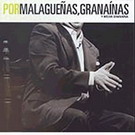Western form of the musical harmony, very present in the flamenco.
Mayor
Media
A flamenco palo, singing and Spanish dancing musical style. Copla with five octosyllable lines, consonant rhyme. We usually repeat one of them (the first or second one) during the singing. It belongs to the "Levante" songs style. We think that its creator is Antonio Chacón.
Media Granaína, Medium Granaina
The medium "granaina", should be from Granada if we trust its name, but they come from the old fandango (verdial) originated in Ronda and Malaga and then they arrived to Granada. Therefore we include the medium "granaina" among the styles from Malaga. Song with a clear melodic line. The flourish of the voice is the bridge to the tone changes.
Melisma
Melisma, in music, is the singing of a single syllable of text while moving between several different notes in succession. Music sung in this style is referred to as melismatic, as opposed to syllabic, where each syllable of text is matched to a single note.
Menor
Form of the musical harmony coming from the West, present in the flamenco.
Milonga, The
Milonga can refer to an Argentine, Uruguayan, and Southern Brazilian form of music which preceded the tango and the dance form which accompanies it, or to the term for places or events where the tango or Milonga are danced (see Milonga (place)). The term milonga comes from a similar expression that means "lyrics".
The Milonga originated in the Río de la Plata area of Argentina and Uruguay and has its roots from various European music. It was very popular in the 1870s. The Milonga was derived from an earlier style of singing known as the payada de contrapunto.
The song was set to a lively 2/4 tempo, and often included musical improvisation. Over time, dance steps and other musical influences were added, eventually giving rise to the tango. Despite 2/4 formula, rhythm is irregular. It is syncopated, consisting of 8 beats with accents on the 1st, (sometimes also 2nd) 4th, 5th, and 7th beats.
Minera
Flamenco song from the Cantiñas group, Cadiz. With a copla of four or five octosyllable lines, born around the middle of XIX. Century.
It belongs to the group of "Levante" songs, to the miner songs. Well known as the songs from the mine of La Union, in Murcia, Cartagena.
Mirabras
The Mirabras contains a sweet and graceful accent of the low Andalusia, but also the strenght and nerve of the rural Andalusia.
Generally sung during the rest, after work. A dance for the flamenco choir in an Andalusian patio; a song insinuating love feeling.
The Mirabras is one of the most important dance of the flamenco folklore.
Modal, Mode
A "scale" is an ordered series of intervals, which, along with the key or tonic, defines that scale's pitches. However, "mode" is usually used in the sense of "scale" applied only to the specific diatonic scales.
In the flamenco "mode": Mi.
Murcianas
Eastern song, belonging to the region of Murcia, not well known, born at the begining of XX. Century.


